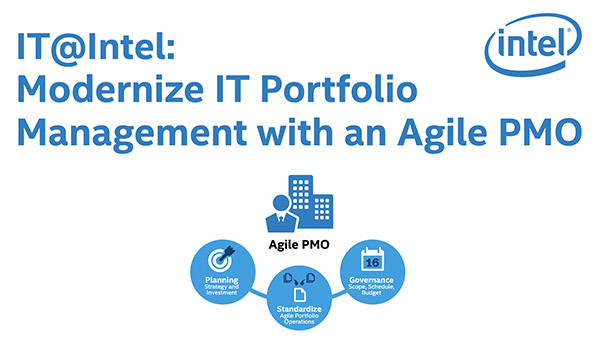Modernize IT Portfolio Management with an Agile PMO

IT Best Practices: Intel IT has formed an Agile Program Management Office (PMO), as a part of Intel IT’s transformation and modernization. We have adopted Agile methodologies to deliver ongoing value to our customers. Instead of long release cycles with massive changes and enhancements, we are organized in small, focused Agile Persistent Teams (APTs) that are self-directed in prioritization and decision making. APTs work in close, daily partnership with representatives from the business to align on priorities. Additionally, we have taken an “investment portfolio” approach to the work that emphasizes cost/ benefit-focused decision making and viewing the IT portfolio as a whole. This allows for trade-o? decisions, evaluation of systemic risks, and a comprehensive understanding of the strategic value the portfolio is intended to deliver.
Our Agile IT PMO provides enterprise-wide support that enables the following:
- Data-driven decision making. Through standard tools and metrics, we provide real-time insights into all programs across IT, enabling us to more efficiently make “once and done” decisions that a?ect our entire portfolio rather than assessing each program or project in isolation. Cross-capability roadmaps help us make decisions based on impact and timing.
- Accountability. Through right-sized governance, we provide support to PMO segments and APTs to help ensure on-scope, on-schedule, on-budget delivery.
- Transparency. We use a standardized dashboard to provide at-a-glance project/program execution health, team capacity, risk mapping, and progress reports.
When armed with accurate, complete, and consistent information, APTs can make informed decisions about the priorities and value they provide to their customers. However, when their decisions impact systems or teams beyond their immediate area, the IT PMO takes advantage of systems of record to present “one version of truth” across the entire IT portfolio.
We measure our PMO against industry-standard benchmarks to understand how far we have come toward our goals, but also to identify and incorporate best-in-class metrics for the future. In early 2020, we partnered with Gartner and surveyed IT leadership to identify opportunities to mature services and provide greater value. Participants included IT general managers, segment leads, principle program managers, Segment PMO leads, as well as members of IT Finance
and Delivery Methods and Coaching. 19 participants completed the survey (40 percent) and four partially completed the survey. The feedback helped us identify where we made the most progress, what was most important to them, and our focus going forward.
We scored the highest on our ability to provide valuable metrics, specifically through the Value Management Office (VMO) dashboard. We nearly reached the benchmark in seven other areas; we also focused primarily on emerging capabilities in cost tracking, investment allocation, and managing risks and interdependencies. These results indicated that we were achieving transparency and standardization, two foundational capabilities necessary to a successful VMO dashboard.
As we move into the future, our newly formed Agile PMO will enable lean principles that ensure clear line-of-sight from strategy to execution. We plan to continue our cross-capability road-mapping to enable the prioritization of
new capabilities and innovation investments as a part of the business value we bring.
For more information on Intel IT Best Practices, please visit intel.com/IT
Posted in:
Intel, Intel IT, IT White Papers, IT@Intel

